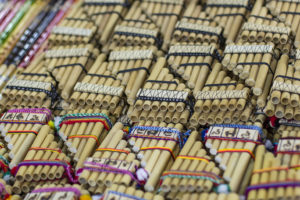By Dr. Lawrence E. Anderson, Founding Director Danville Community BandOf all the non-western music in the world, one of the most unknown, misunderstood and unappreciated is African music. African music is usually classified as North African, which is more Islamic in nature, and Sub-Saharan, considered more traditional tribal and native to the continent. It is, however, rapidly giving way to a more urban and citified style of music.
Prior to 1950 recorded examples of authentic tribal music were woefully absent, as it is today. As more and more anthropologists, ethnomusicologists and historians investigate and uncover unknown facts and traditions, we will gain a better understanding and knowledge of traditional African music.
Music has been a driving force in the lives of people through the ages. This is true, not only in Africa but in virtually all societies and civilization in recorded history. Music and dance permeate nearly all aspects of African tribal life. Music is a vital component in rituals of birth, puberty, secret society initiations, marriage, jobs, hunting and farming.
Tribal people use music to express their joys, sorrows, hopes, fears, anticipations and longings. In parts of Africa, everyday life is lived in the most basic and simplest terms. Music is important in life’s daily existence. Music is also prevalent in legal, political and historical celebrations and ceremonies. It pervades almost all aspects of everyday life occurrences and happenings—it is all encompassing.
Ceremonial music with costumes, masks and instruments can take on an aura of sacredness. An example of this is the Watutsi tribe’s royal drums. They have been known to possess a “soul.” The soul is represented by a small stone or pebble inside the head of the drum. It is believed that the stone, or soul, can get rid of evil spirits.
Along with the more formal aspects of African music there are many examples of music and dance for entertainment purposes. Through the ceremonies of song and dance, the tribe itself grows strong. Interestingly, Western composers have used elements of primitive music in their varied compositions.
Instruments: African instruments are many and varied. Some are quite foreign compared to western instruments. They fall into four main categories:
Aerophones are instruments whose tones are produced by air causing vibrations that generate sound. They include wooden or bamboo flutes, whistles, trumpets and ivory horns, panpipes and nose flutes.
Chordophones are instruments that use strings as the tone-producing elements. They are: Zither, Sanzu, Lute, Lyre and the Musical Bow.
Idiophones are struck shaken or plucked. They include Rattles, Xylophones, Triangles, Iron Bells and Slit Drums. Slit Drums are important for communication and signaling and some say has magical powers and is often used in magical rites. The Sanza, indigenous to Central Africa, is a small plucked idiophone. This should not be confused with the Sanzu mentioned earlier.
Membranophones are primarily drums. These instruments have either a single or double-head skins. Sound is produced by vibration of a stretched membrane that is struck by a stick, hand or friction (rubbing.) Pitch differences can be achieved by tightening or loosening the skin heads. These drums are used for major ceremonial purposes and also secular events. There are other types of drums that are un-pitched.
Musical Characteristics: Rhythm and tempo in African music are very complex. The sound of African music scales are different to Western ears. The most common form in African music is the repetition of a musical idea that occurs throughout the song. Dynamics or volume, are generally at a high level. Musical motion is constant and complex as melody and rhythm converge. Locally their music has occasional shouts and screams. Excessive breathiness is often present. Humming, yodeling and some animal imitations are common. Singing is mostly straight without vibrato; it is often acapella or accompanied by instruments.
Hocket is both a vocal and instrumental technique where one voice or instrument will stop and another will come in, usually for one note or a short phrase, creating a hiccupping effect.
There is a decline of traditional music, due to the mingling of Sub-Saharan music with western and eastern civilizations. Today there is much evidence of a global view of African music emerging as an art.
Please submit your questions and comments to: banddirector01@comcast,net. Visit our website at www.danvilleband,org for up-to-date information about the Danville Community Band. Join the Danville Community Band as they present their annual concert, “A Day at the Museum,” Sunday, April 2, 2017 at 2:00 p.m. 3700 Blackhawk Plaza Circle. Free concert with admission to the Blackhawk Museums. Free parking.
Leave a Reply